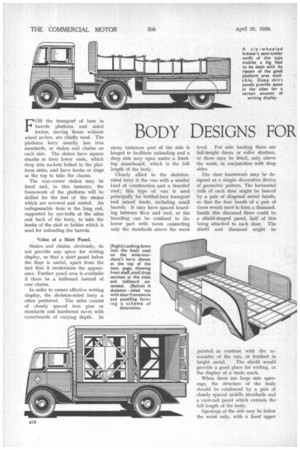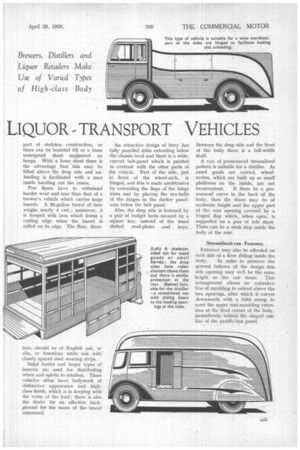BODY DESIGNS FOR LIQUOR TRANSPORT VEHICLES
Page 44

Page 45

If you've noticed an error in this article please click here to report it so we can fix it.
FOR the transport of beer in barrels platform and sided lorries, having floors without wheel arches, are chiefly used. The platform lorry usually has iron standards, or stakes and chains on each side. The stakes have square shanks at their lower ends, which drop into sockets bolted to the platform sides, and have hooks or rings at the top to take the chains.
The rear-corner stakes may be fixed and, in this instance, the framework of the platform will be drilled for the feet of the stakes which are screwed and nutted. An indispensable item is the long rod, supported by eye-bolts at the sides and back of the lorry, to take the hooks of the skid or ladder which is used for unloading the barrels.
Value of a Skirt Panel.
_ Stakes and chains, obviously, do not provide any space for writing display, so that a skirt panel below the floor is useful, apart from the fact that it modernizes the appearance. Further panel area is available if there be a tailboard instead of rear chains.
In order to ensure effective writing display, the skeleton-sided lorry is often preferred. The sides consist of closely spaced iron pins or standards and hardwood raves with na me-boards of varying depth. In
many instances part of the side is hinged to facilitate unloading and a deep side may open under a fixedtop nameboard, which is the full length of the body.
Closely allied to the skeletonsided lorry is the van with a similar kind of construction and a boarded roof; this type of van is used principally for bottled-beer transport and mixed loads, including small barrels. It may have spaced boarding between floor and roof, or the boarding can be confined to the lower part with raves connecting only the standards above the waist
level. For side loading there are full-height doors or roller shutters, or these may be fitted, only above the waist, in conjunction with drop sides.
The door framework may be de. signed as a simple decorative device of geometric pattern. The horizontal sails of each door might be braced by a pair of diagonal metal bands, so that the four bands of a pair of doors would meet to form a diamond. Inside this diamond there could be a shield-shaped panel, half of this being attached to each door. The shield and diamond might be painted in contrast with the remainder of the van, or finished in bright metal. The shield would provide a good place for writing, or the display of a trade mark.
When there are large side openings, the structure of the body should be reinforced by a pair of closely spaced middle standards and a cant-rail panel which extends the full length of the body.
Openings at the side may be below the waist only, with a fixed upper part of skeleton construction, or there can be boarded tilt or a loose waterproof sheet supported on hoops. With a loose, sheet there is the advantage that this may be lifted above the drop side and unloading is facilitated with a man inside handing out the crates.
Few floors have to withstand harder wear and tear than that of a brewer's vehicle which carries large barrels. A 36-gallon barrel of beer weighs nearly 4 cwt. ; moreover, is hooped with iron which forms a cutting edge when the barrel is rolled on its edge. The floor, there fore, should be of English oak, or elm, or American white oak with closely spaced steel wearing strips.
Sided lorries and larger types of boxvan are used for distributing wines and spirits to retailers. These vehicles often have bodywork of distinctive appearance and highclass finish, which is in keeping with the value of the load ; there is also the desire for an effective background for the name of the brand concerned.
An attractive design of lorry has fully panelled sides extending below the chassis level and there is a wide, curved belt-panel which is painted in contrast with the other parts of the vehicle. Part of the side, just in front of the wheel-arch, is hinged, and this is made unobtrusive by concealing the flaps of the hinge irons and by placing the eye-bolts of the hinges in the darker panelarea below the belt panel.
Also, the drop side is fastened by a pair of budget locks secured by a square key, instead of the usual slotted stud-plates and keys. Between the drop side and the front of the body there is a full-width shelf.
A van of pronounced streamlined pattern is suitable for a distiller. As cased goods are carried, wheelarches, which are built up as small platforms on the inside, are not
inconvenient. If there be a pronounced curve to the back of the body, then the doors may be of moderate height and the upper part of the rear opening covered by a hinged flap which, when open; is supported on a pair of side stays. There can be a sunk step inside the body at the rear.
Streamlined-van Features. Entrance may also be afforded on each side of a door sliding inside the body. In order to preserve the general balance of the design this side opening may well be the same height as the cab doors. This arrangement allows an unbroken line of moulding to extend above the two openings, after which it curves downwards with a bold sweep to meet the upper roof-moulding extension at the hind corner of the body, immediately behind the shaped outline of the paddle-box panel.






















































































